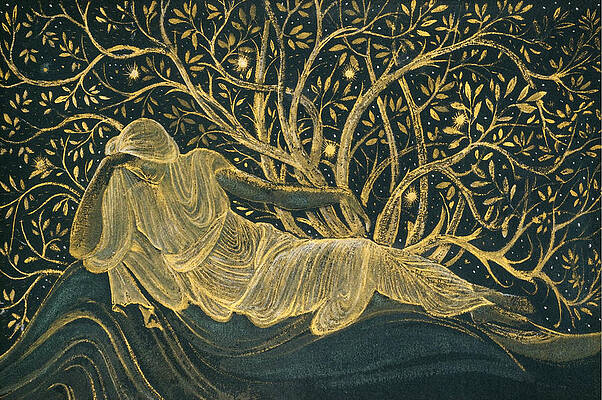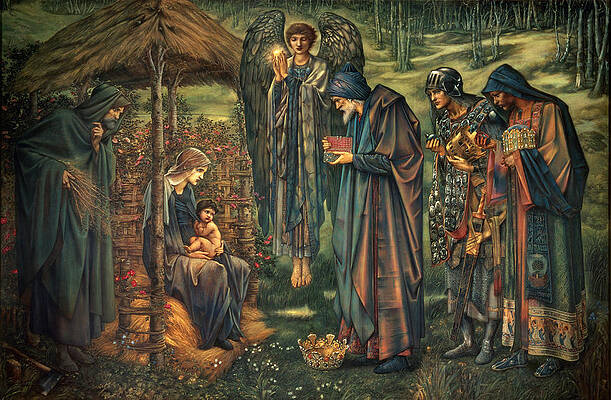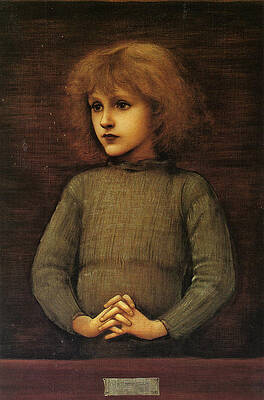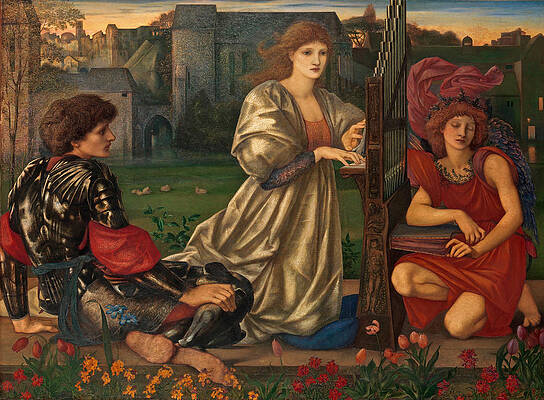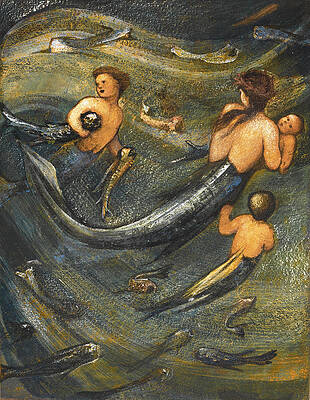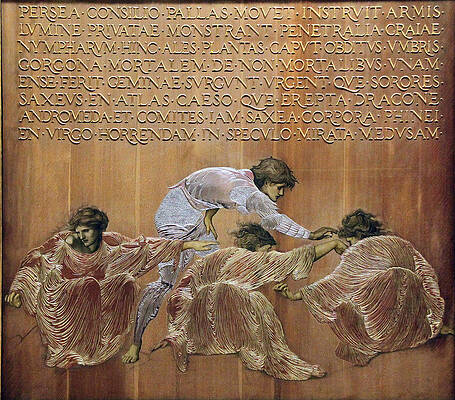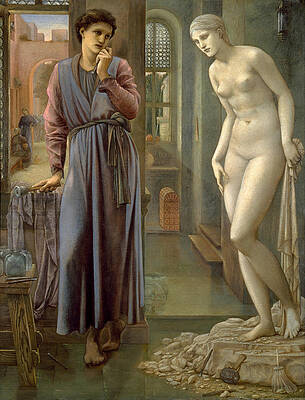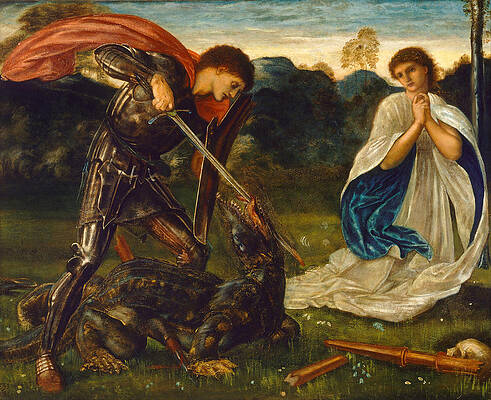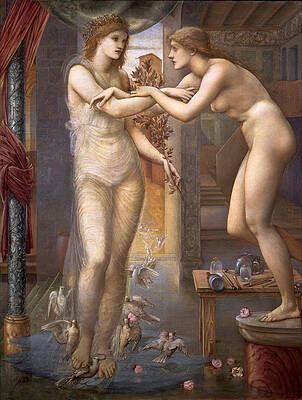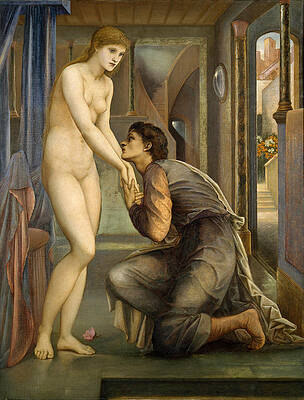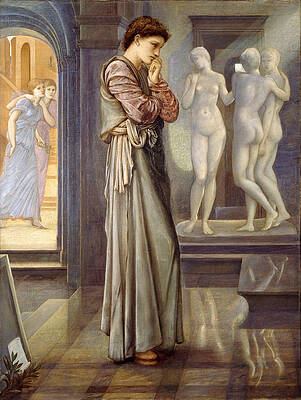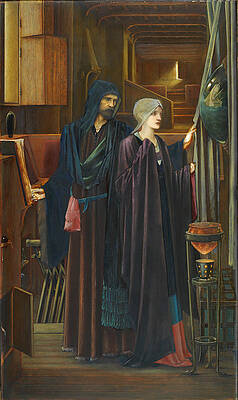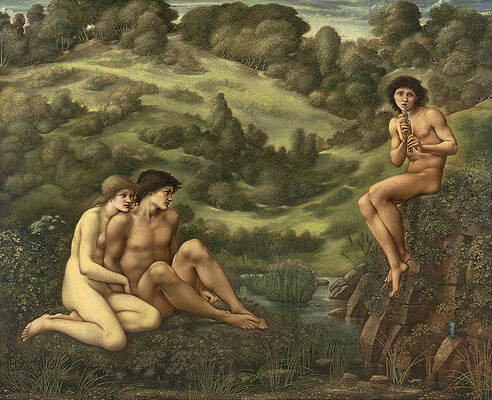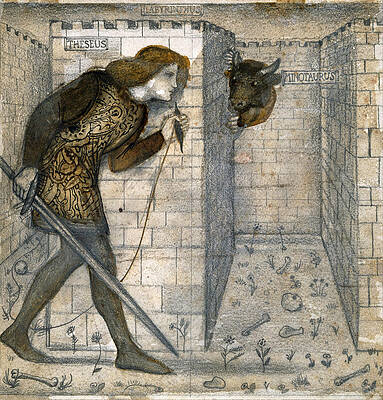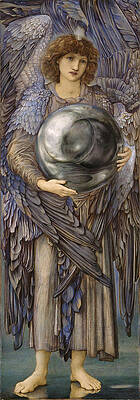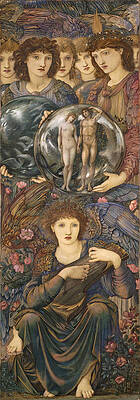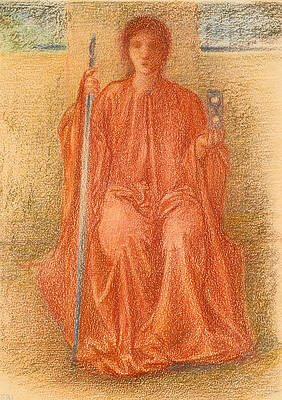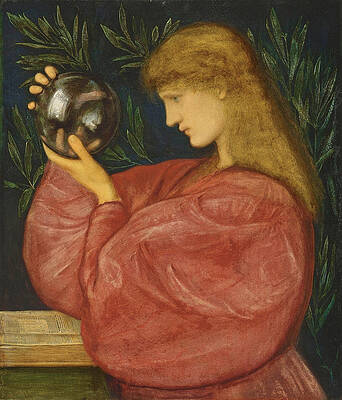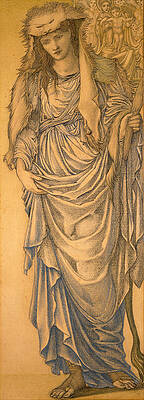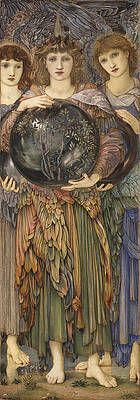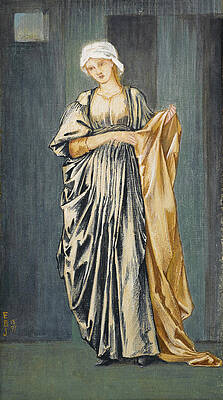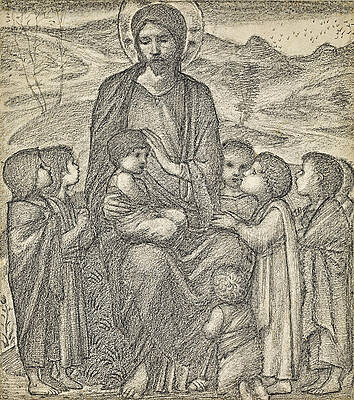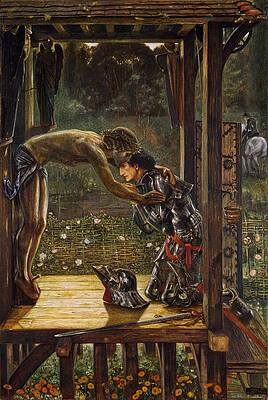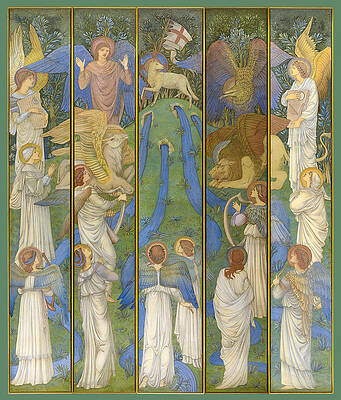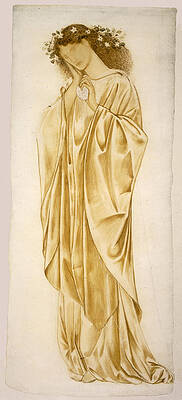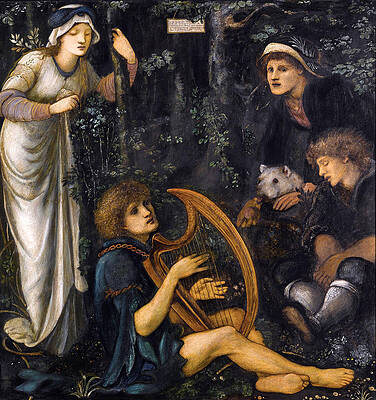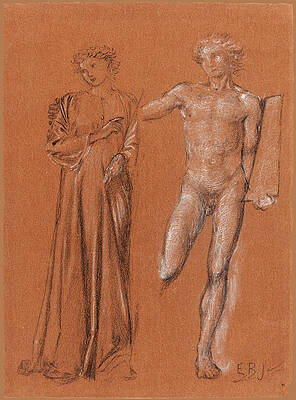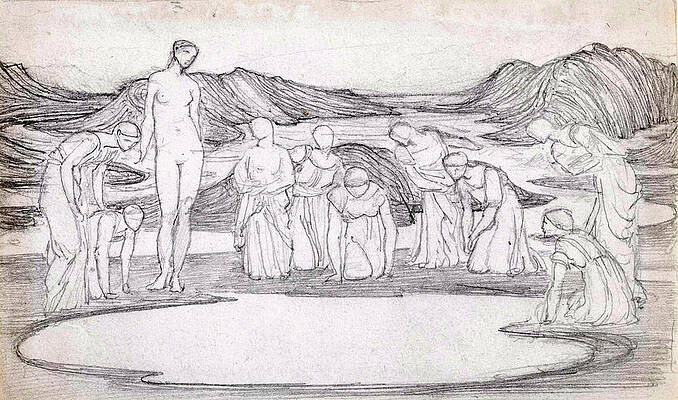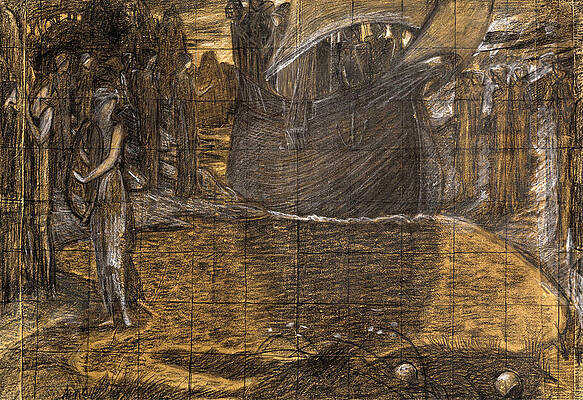Sir Edward Burne-Jones
Paintings
A Reclining Female Figure
The Star of Bethlehem
Philip Comyns Carr
The Love Song
The Mermaid Family
Perseus and the Graiae
Pygmalion and the Image - The Hand Refrains
The fight. St George kills the dragon VI
The Feast of Peleus
Pygmalion and the Image - The Godhead Fires
Pygmalion and the Image - The Soul Attains
Pygmalion and the Image - The Heart Desires
Flamma Vestalis
The Wizard
Hope
Dancing Girls
A Sea-Nymph
The Battle of Beth-Horon - Joshua Commanding the Sun and Moon to Stand Still
The garden of Pan
Perseus and Andromeda
The Wheel of Fortune
Portrait of Maria Zambaco
The Depths Of The Sea
Theseus and the Minotaur in the Labyrinth
The Days of Creation. The First Day
The Days of Creation. The Sixth Day
Time
The Guardian Angel
Astrologia
Female Nude. Three Studies possibly for Venus
The Tiburtine Sibyl
The Days of Creation. The Third Day
Ancilla Matutina
Christ blessing Children
The Car of Love
The Merciful Knight
Paradise, with the Worship of the Holy Lamb
Maria Zambaco, Profile Study
Ariadne
The Madness of Sir Tristram
Orpheus and Eurydice
Cupid's Hunting Fields
Study for the mirror of venus
Study for the sirens

The Perseus Series - Study of Perseus in Armour for The Finding of MedusaPygmalion and the Image - The Godhead Fires
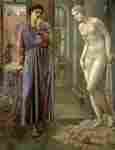
Pygmalion and the Image - The Hand RefrainsPygmalion and the Image - The Heart DesiresPygmalion and the Image - The Soul Attains
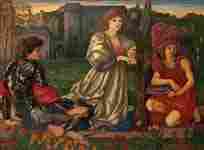
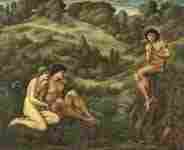
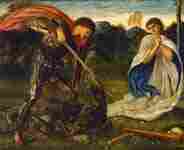
The fight: St George kills the dragon VI
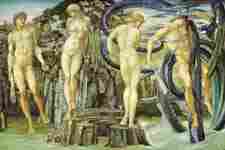


The Battle of Beth-Horon - Joshua Commanding the Sun and Moon to Stand Still

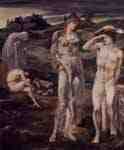

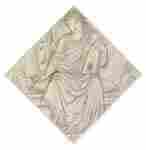

Achievment Galahad the Sang Graal
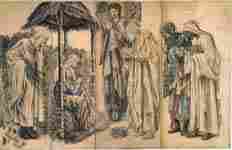
Adoration of the Magi Tapestry cartoon
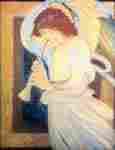
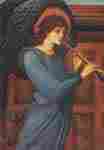
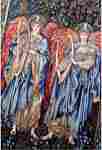

Apse mosaic of St Paul's within the Walls in Rome - Patroness of Music

Apse of St Paul's within the Walls in Rome - The Son of Man






Briar Rose - The Sleeping Beauty

Briar Rose, Garden Court (detail)
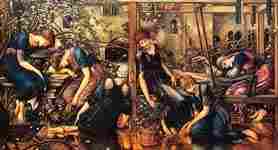
Briar Rose, Garden Court, Detail
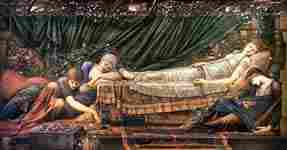
Briar Rose, Series - IV, The Sleeping Beauty
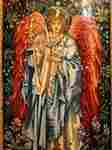
Brockhampton-by-Ross, Herefordshire, North of altar, tapestry
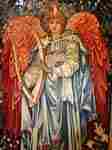
Brockhampton-by-Ross, Herefordshire, South of altar, tapestry



Christ in Glory (Salvator Mundi)
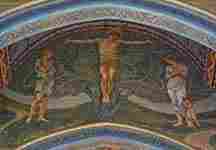
Christ on the Tree of Life (mosaic)

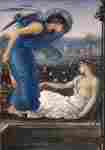
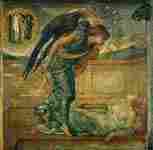

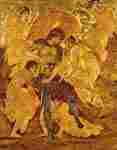
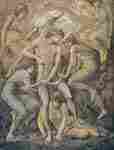





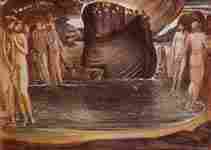
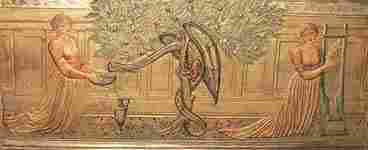
Detail from cassone by Burne-Jones
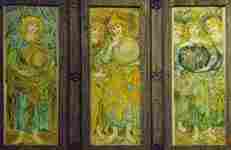
Dyfrig Chapel at Llandaff Cathedral, Cardiff - fourth panel_ 1 Days One, Two and Three (porcellan)

Dyfrig Chapel at Llandaff Cathedral, Cardiff - fourth panel_ 2 Days Four, Five and Six (porcellan)


Fair Rosamund and Queen Eleanor
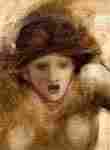

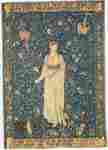

George James Howard, Earl of Carlisle (1843-1911),

Georgiana Burne-Jones, their children Margaret and Philip in the background

Goauche of Dorigen of Bretagne longing for the safe return of her husband
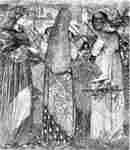

Gudrun Setting Fire To Atli's Palace


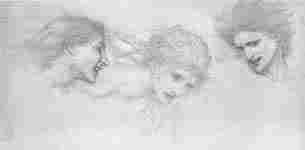
Heads of Despight, Cruelty, and Dame Amoret, study for The Masque of Cupid

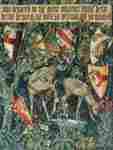
Holy Grail tapestry Verdure detail Verdure with Deer and Shields
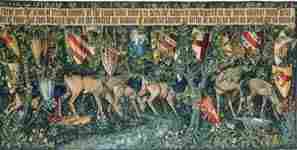

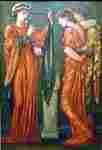
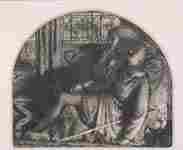
I rose up in the silent night I made my dagger sharp and bright



King Cophetua and the Beggar Maid

King Cophetua and the Beggar Maid

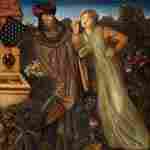
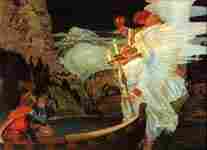

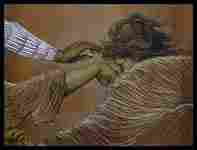


Lancelot at the Chapel of the Holy Grail,
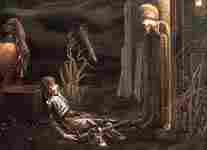
Lancelot Chapel of the Holy Grail,
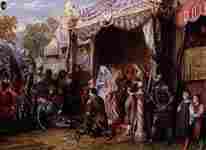
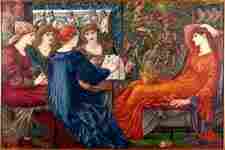

Llandaff Cathedral, Wales - The Six Days of Creation in ceramic as a reredos
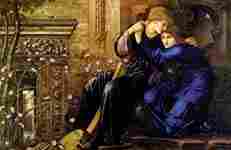
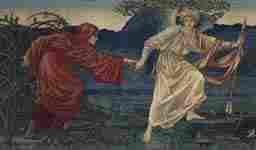
Love and the Pilgrim, tapestry
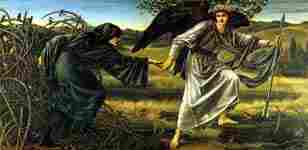

Marriage Procession. Arthur and Guinevere


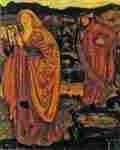
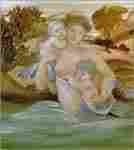
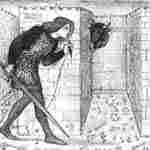

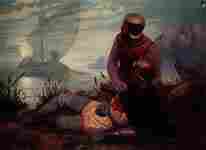

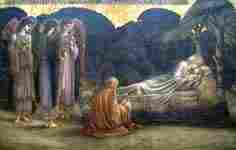
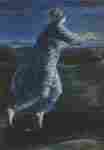


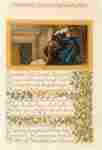
Page from an illuminated manuscript of the Rubaiyat of Omar Khayyam
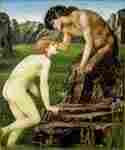

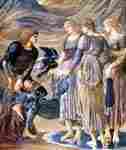



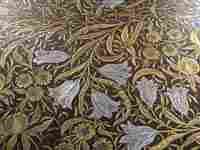
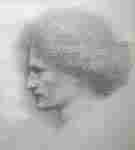
Portrait of Ignacy Jan Paderewski,


Portrait of Margaret (1866-1953), daughter of Edward Coley Burne-Jones
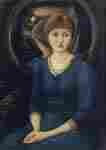
Portrait of Margaret Burne-Jones, the daughter of the painter
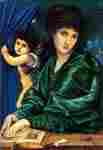
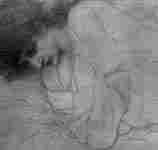

Portrait of the artist’s Family, Lady Burne Jones with her son Philip and Daughter Margaret
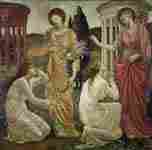
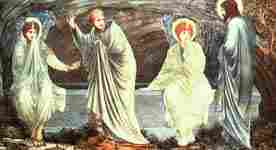

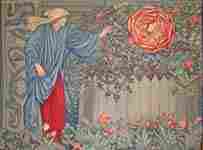
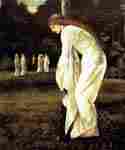
Saint George and The Dragon. The Princess Tied to the Tree,



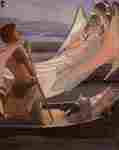
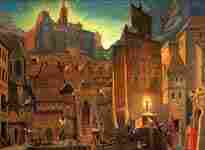
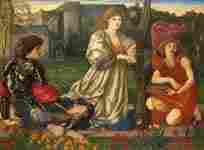


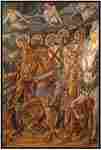
St Paul within the Walls - Burne-Jones Mosaic



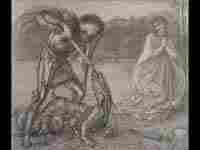
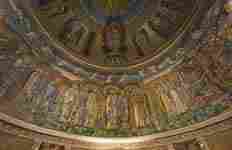
St. Paul's Episcopal church in Rome - The Saints in Bright Array (mosaic)
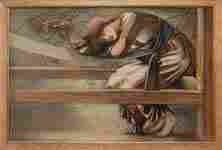
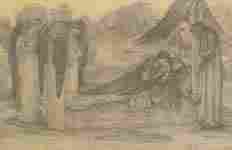
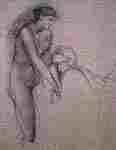
Study for The Soul Attains, Pygmalion and Galatea
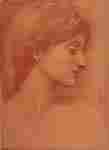
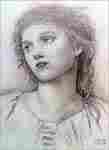

Study of a musician for The Golden Stairs

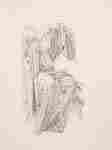
Study of drapery for Queen Morgan le Fay at the head of King Arthur




Study of the head of a girl for The Golden Stairs

Study of two girls for the Golden Stairs
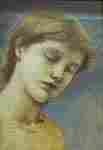


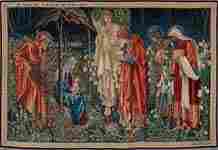

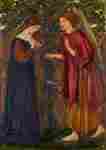
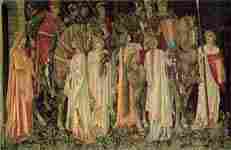
The Arming and Departure of the Knights
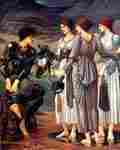

The Attainment The Vision of the Holy Grail to Sir Galahad, Sir Bors, and Sir Perceval
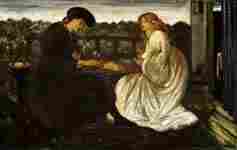

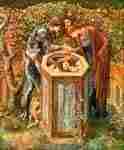


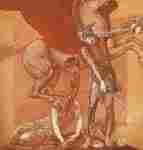
The Birth of Pegasus and Chrysaor,
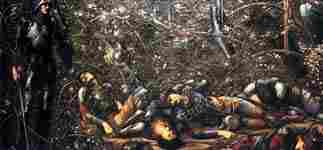
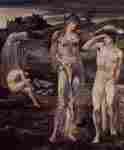
The Calling of Perseus (The Perseus Cycle 1)

The Car of Love, or Love's Wayfaring
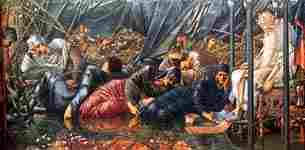

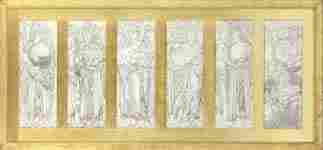
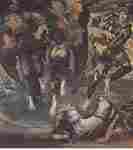
The Death of Medusa (The Perseus Cycle 5)

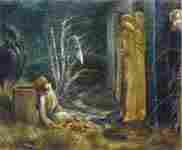
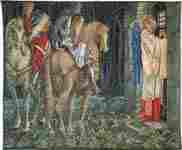
The Failure of Sir Gawaine, Sir Gawaine and Sir Uwaine at the Ruined Chapel,
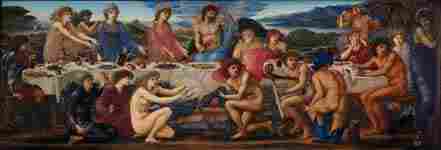
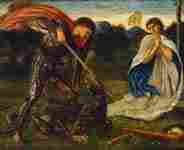
The fight- St George kills the dragon VI,
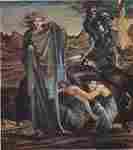
The Finding of Medusa (The Perseus Cycle 4),

The Flower Book - Arbor Tristis

The Flower Book - False Mercury
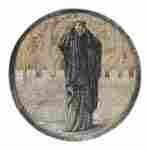
The Flower Book - Helen's Tears,
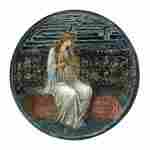
The Flower Book - Love in a Tangle,
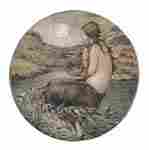
The Flower Book - Rose of Heaven
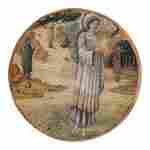
The Flower Book - Star of Bethlehem
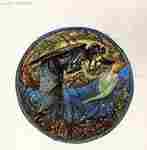
The Flower Book - Wake Dearest
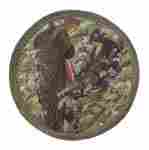
The Flower Book - Witches Tree,
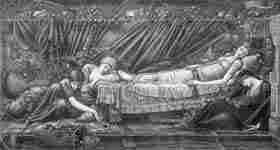
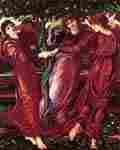

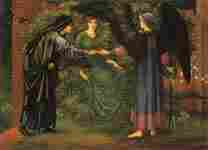
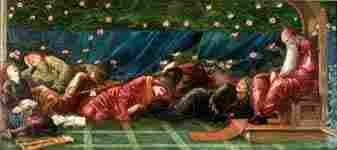
The King and His Court (small series The Wild Rose),
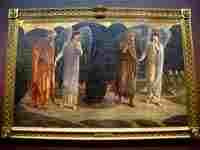
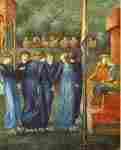
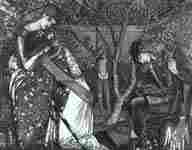
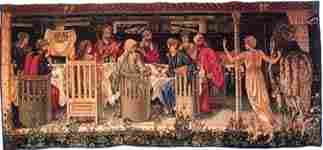
The Knights of the Round Table Summoned to the Quest by the Strange Damsel
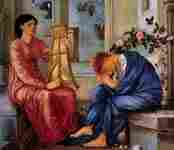
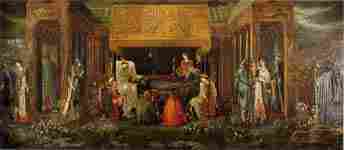
The Last Sleep of Arthur in Avalon
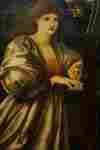
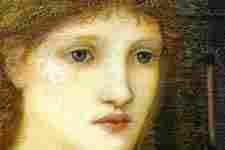
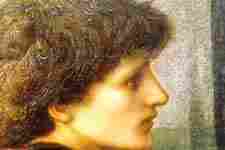
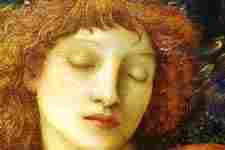
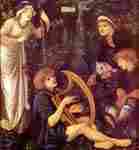
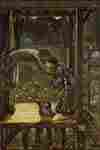
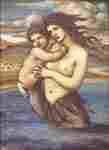
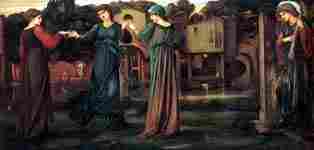
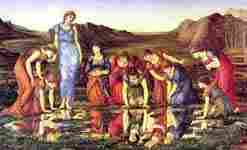
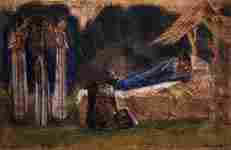
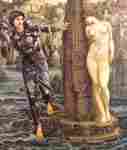
The Perseus Series. Rock of Doom
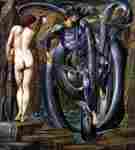
The Perseus Series. The Doom Fulfilled
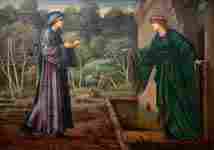
The Pilgrim at the Gate of Idleness

The Pilgrim at the Gate of Idleness, detail
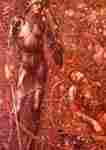
The Prince Enters the Briar Wood
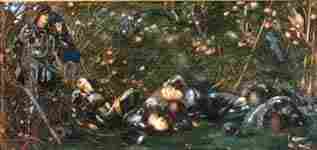
The Prince enters the forest (small series The Wild Rose)

The prince enters the thorn forest

The Princess Sabra Led to the Dragon

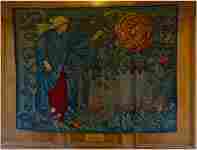
The Romance of the Rose in Rhodes House





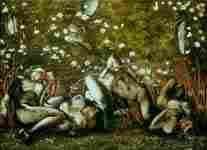

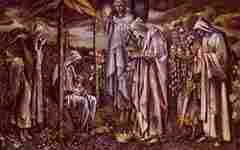



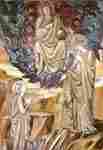
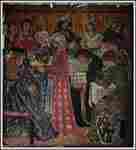

The wedding procession of Psyche
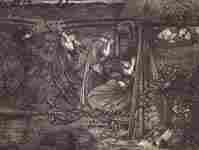

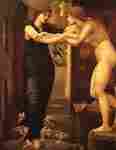
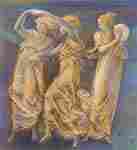
Three Female Figures Dancing And Playing
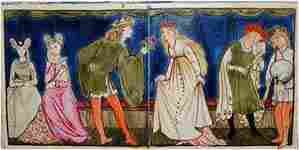
Tile designed by Burne Jones which once formed part of a fireplace at 'The Hill', Whitley, Surrey








Ariadne and Phyllis from Chaucer's 'The Legend of Good Women

Ariadne and Phyllis from Chaucer's 'The Legend of Good Women

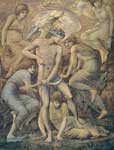
Pygmalion, First Series
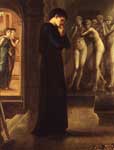
Pygmalion I , The Heart Desires
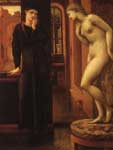
Pygmalion II, The Hand Refrains
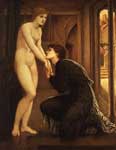
Pygmalion IV The Soul Attains,
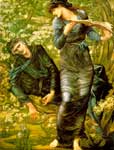
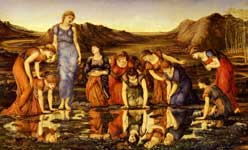

The Three GracesDrawings

Design for the Perseus story, scene:: The fright head
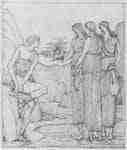
Design for the Perseus story scene: Perseus and the Sea Nymphs

Design for the Perseus story scene: Perseus and the Sea Nymphs
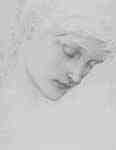


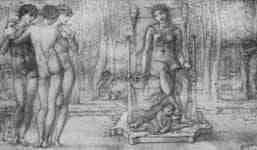



Fine Art Prints | Greeting Cards | Phone Cases | Lifestyle | Face Masks | Men's , Women' Apparel | Home Decor | jigsaw puzzles | Notebooks | Tapestries | ...
Sir Edward Coley Burne-Jones, 1st Baronet ARA (28 August 1833 –; 17 June 1898) was a British artist and designer closely associated with the later phase of the Pre-Raphaelite movement, who worked closely with William Morris on a wide range of decorative arts as a founding partner in Morris, Marshall, Faulkner & Co. Burne-Jones was closely involved in the rejuvenation of the tradition of stained glass art in Britain; his stained glass works include the windows of St. Philip's Cathedral, Birmingham, St Martin in the Bull Ring, Birmingham, Holy Trinity Church, Sloane Square, Chelsea, St Martin's Church in Brampton, Cumbria (the church designed by Philip Webb), St Michael's Church, Brighton, All Saints, Jesus Lane, Cambridge, Christ Church, Oxford and in St. Anne's Church, Brown Edge, Staffordshire Moorlands. Burne-Jones's early paintings show the heavy inspiration of Dante Gabriel Rossetti, but by the 1860s Burne-Jones was discovering his own artistic "voice". In 1877, he was persuaded to show eight oil paintings at the Grosvenor Gallery (a new rival to the Royal Academy). These included The Beguiling of Merlin. The timing was right, and he was taken up as a herald and star of the new Aesthetic Movement.
In addition to painting and stained glass, Burne-Jones worked in a variety of crafts; including designing ceramic tiles, jewellery, tapestries, mosaics and book illustration, most famously designing woodcuts for the Kelmscott Press's Chaucer in 1896.
Early life
Burne-Jones with William Morris, 1874, by Frederick Hollyer.
Edward Coley Burne Jones (the hyphen came later) was born in Birmingham, the son of a Welshman, Edward Richard Jones, a frame-maker at Bennetts Hill, where a blue plaque commemorates the painter's childhood. His mother Elizabeth Coley Jones died within six days of his birth, and he was raised by his grieving father and the family housekeeper, Ann Sampson, an obsessively affectionate but humorless and unintellectual local girl.[1][2] He attended Birmingham's King Edward VI grammar school from 1844[3] and the Birmingham School of Art from 1848 to 1852, before studying theology at Exeter College, Oxford.[4] At Oxford he became a friend of William Morris as a consequence of a mutual interest in poetry. The two Exeter undergraduates, together with a small group of Jones' friends from Birmingham known as the Birmingham Set,[5] speedily formed a very close and intimate society, which they called "The Brotherhood". The members of the Brotherhood read John Ruskin and Tennyson, visited churches, and worshipped the Middle Ages. At this time Burne-Jones discovered Thomas Malory's Le Morte d'Arthur which was to be so influential in his life. At that time neither Burne-Jones nor Morris knew Rossetti personally, but both were much influenced by his works, and met him by recruiting him as a contributor to their Oxford and Cambridge Magazine which Morris founded in 1856 to promote their ideas.[3][6]
Burne-Jones had intended to become a church minister, but under Rossetti's influence both he and Morris decided to become artists, and Burne-Jones left college before taking a degree to pursue a career in art. In February 1857, Rossetti wrote to William Bell Scott
Two young men, projectors of the Oxford and Cambridge Magazine, have recently come up to town from Oxford, and are now very intimate friends of mine. Their names are Morris and Jones. They have turned artists instead of taking up any other career to which the university generally leads, and both are men of real genius. Jones's designs are marvels of finish and imaginative detail, unequalled by anything unless perhaps Albert Dürer's finest works.[3]
Marriage and family
In 1856 Burne-Jones became engaged to Georgiana "Georgie" MacDonald (1840–1920), one of the MacDonald sisters. She was training to be a painter, and was the sister of Burne-Jones's old school friend. The couple married in 1860, after which she made her own work in woodcuts and became a close friend of George Eliot. (Another MacDonald sister married the artist Sir Edward Poynter, a further sister married the ironmaster Alfred Baldwin and was the mother of the Prime Minister Stanley Baldwin, and yet another sister was the mother of Rudyard Kipling. Kipling and Baldwin were thus Burne-Jones's nephews by marriage).
Georgiana bore a son, Philip, in 1861. A second son, born in the winter of 1864 while Georgiana was gravely ill with scarlet fever, died soon after birth. The family soon moved to 41 Kensington Square, and their daughter Margaret was born there in 1866.[7]
In 1867 Burne-Jones and his family settled at the Grange, an 18th-century house set in a large garden in North End Road, Fulham, London. For much of the 1870s Burne-Jones did not exhibit, following a spate of bitterly hostile attacks in the press, and a passionate affair (described as the "emotional climax of his life"[8]) with his Greek model Maria Zambaco which ended with her trying to commit suicide by throwing herself in Regent's Canal.[8][9] During these difficult years Georgiana developed a close friendship with Morris, whose wife Jane had fallen in love with Rossetti. Morris and Georgie may have been in love, but if he asked her to leave her husband, she refused. In the end, the Burne-Joneses remained together, as did the Morrises, but Morris and Georgiana were close for the rest of their lives.[10]
In 1880 the Burne-Joneses bought Prospect House in Rottingdean, near Brighton in Sussex, as their holiday home, and soon after the next door Aubrey Cottage to create North End House, reflecting the fact that their Fulham home was in North End Road. (Years later, in 1923, Sir Roderick Jones, head of Reuters, and his wife, playwright and novelist Enid Bagnold, were to add the adjacent Gothic House to the property and which became the inspiration and setting for her play The Chalk Garden).
His troubled son Philip became a successful portrait painter and died in 1926. His adored daughter Margaret (died 1953) married John William Mackail (1850–1945), the friend and biographer of Morris, and Professor of Poetry at Oxford from 1911–1916. Their children were the novelists Angela Thirkell and Denis Mackail. In an edition of the boys' magazine, Chums (No. 227, Vol. V, 13 January 1897) an article on Burne-Jones stated that "....his pet grandson used to be punished by being sent to stand in a corner with his face to the wall. One day on being sent there he was delighted to find the wall prettily decorated with fairies, flowers, birds, and bunnies. His indulgent grandfather had utilised his talent to alleviate the tedium of his favourite's period of penance."
Artistic career
Early years: Rossetti and Morris
Burne-Jones once admitted that after leaving Oxford he "found himself at five-and-twenty what he ought to have been at fifteen." He had had no regular training as a draughtsman, and lacked the confidence of science. But his extraordinary faculty of invention as a designer was already ripening; his mind, rich in knowledge of classical story and medieval romance, teemed with pictorial subjects; and he set himself to complete his equipment by resolute labour, witnessed by innumerable drawings. The works of this first period are all more or less tinged by the influence of Rossetti; but they are already differentiated from the elder master's style by their more facile though less intensely felt elaboration of imaginative detail. Many are pen-and-ink drawings on vellum, exquisitely finished, of which 1856's Waxen Image is one of the earliest and best examples. Although subject, medium and manner derive from Rossetti's inspiration, it is not the hand of a pupil merely, but of a potential master. This was recognized by Rossetti himself, who before long avowed that he had nothing more to teach him.[11]
Burne-Jones's first sketch in oils dates from this same year, 1856; and during 1857 he made for Bradfield College the first of what was to be an immense series of cartoons for stained glass. In 1858 he decorated a cabinet with the Prioress's Tale from Geoffrey Chaucer's Canterbury Tales, his first direct illustration of the work of a poet whom he especially loved and who inspired him with endless subjects. Thus early, therefore, we see the artist busy in all the various fields in which he was to labour.[11]
In the autumn of 1857 Burne-Jones joined Morris, Valentine Prinsep, J. R. Spencer Stanhope[12] and others in Rossetti's ill-fated scheme to decorate the walls of the Oxford Union. None of the painters had mastered the technique of fresco, and their pictures had begun to peel from the walls before they were completed. In 1859 Burne-Jones made his first journey to Italy. He saw Florence, Pisa, Siena, Venice and other places, and appears to have found the gentle and romantic Sienese more attractive than any other school. Rossetti's influence still persisted, and is visible, more strongly perhaps than ever before, in the two watercolours of 1860, Sidonia von Bork and Clara von Bork.[11] Both paintings illustrate the 1849 gothic novel Sidonia the Sorceress by Lady Wilde, a translation of Sidonia Von Bork: Die Klosterhexe (1847) by Johann Wilhelm Meinhold.[13]
Decorative arts: Morris & Co.
Main article: Morris & Co.
In 1861, William Morris founded the decorative arts firm of Morris, Marshall, Faulkner & Co. with Rossetti, Burne-Jones, Ford Madox Brown and Philip Webb as partners, together with Charles Faulkner and Peter Paul Marshall, the former of whom was a member of the Oxford Brotherhood, and the latter a friend of Brown and Rossetti.[6] The prospectus set forth that the firm would undertake carving, stained glass, metal-work, paper-hangings, chintzes (printed fabrics), and carpets.[11] The decoration of churches was from the first an important part of the business. The work shown by the firm at the 1862 International Exhibition attracted much notice, and within a few years it was flourishing. Two significant secular commissions helped establish the firm's reputation in the late 1860s: a royal project at St. James's Palace and the "green dining room" at the South Kensington Museum (now the Victoria and Albert) of 1867 which featured stained glass windows and panel figures by Burne-Jones.[14]
Blue plaque, 41 Kensington Square, Kensington, London - home from 1865-67
In 1871 Morris & Co. were responsible for the windows at All Saints, designed by Burne-Jones for Alfred Baldwin, his wife's brother-in-law. The firm was reorganized as Morris & Co. in 1875, and Burne-Jones continued to contribute designs for stained glass, and later tapestries until the end of his career. Stained glass windows in the Christ Church cathedral and other buildings in Oxford are by William Morris & Co. with designs by Burne-Jones[15][16] Stanmore Hall was the last major decorating commission executed by Morris & Co. before Morris's death in 1896. It was also the most extensive commission undertaken by the firm, and included a series of tapestries based on the story of the Holy Grail for the dining room, with figures by Burne-Jones.[17]
In 1891 Jones was elected a member of the Art Workers Guild.
Illustration work
Although known primarily as a painter, Burne-Jones was also an illustrator, helping the Pre-Raphaelite aesthetic to enter mainstream awareness. In addition, he designed books for the Kelmscott Press between 1892 and 1898. His illustrations appeared in the following books, among others:[18]
The Fairy Family by Archibald Maclaren (1857)
The Earthly Paradise by William Morris (not completed)
The Works of Geoffrey Chaucer by Geoffrey Chaucer (1896)
Bible Gallery by Dalziel (1881)
Painting
The Beguiling of Merlin, 1874
In 1864 Burne-Jones was elected an associate of the Society of Painters in Water-Colours (also known as the Old Water-Colour Society), and exhibited, among other works, The Merciful Knight, the first picture which fully revealed his ripened personality as an artist. The next six years saw a series of fine watercolours at the same gallery.[11] In 1866 Mrs Cassavetti commissioned Burne-Jones to paint her daughter, Maria Zambaco, in Cupid finding Psyche, an introduction which led to their tragic affair. In 1870, Burne-Jones resigned his membership following a controversy over his painting Phyllis and Demophoön. The features of Maria Zambaco were clearly recognizable in the barely draped Phyllis (as they are in several of Burne-Jones's finest works), and the undraped nakedness of Demophoön coupled with the suggestion of female sexual assertiveness offended Victorian sensibilities. Burne-Jones was asked to make a slight alteration, but instead "withdrew not only the picture from the walls, but himself from the Society."[19]
During the next seven years, 1870–1877, only two works of the painter's were exhibited. These were two water-colours, shown at the Dudley Gallery in 1873, one of them being the beautiful Love among the Ruins, destroyed twenty years later by a cleaner who supposed it to be an oil painting, but afterwards reproduced in oils by the painter. This silent period was, however, one of unremitting production. Hitherto Burne-Jones had worked almost entirely in water-colours. He now began a number of large pictures in oils, working at them in turn, and having always several on hand. The first Briar Rose series, Laus Veneris, the Golden Stairs, the Pygmalion series, and The Mirror of Venus are among the works planned and completed, or carried far towards completion, during these years.[11] These years also mark the beginnings of Burne-Jones's partnership with the fine-art photographer Frederick Hollyer, whose reproductions of paintings and—especially—drawings would expose a wider audience to Burne-Jones's works in the coming decades.[20]
"King Cophetua and the Beggar Maid", 1884, currently in the Tate Gallery, London.
At last, in May 1877, the day of recognition came, with the opening of the first exhibition of the Grosvenor Gallery, when the Days of Creation, The Beguiling of Merlin, and the Mirror of Venus were all shown. Burne-Jones followed up the signal success of these pictures with Laus Veneris, the Chant d'Amour, Pan and Psyche, and other works, exhibited in 1878. Most of these pictures are painted in brilliant colours. A change is noticeable the next year, 1879, in the Annunciation and in the four pictures making up the second series of Pygmalion and the Image; the former of these, one of the simplest and most perfect of the artist's works, is subdued and sober; in the latter a scheme of soft and delicate tints was attempted, not with entire success. A similar temperance of colours marks The Golden Stairs, first exhibited in 1880. The almost sombre Wheel of Fortune was shown in 1883, followed in 1884 by King Cophetua and the Beggar Maid, in which Burne-Jones once more indulged his love of gorgeous colour, refined by the period of self-restraint. He next turned to two important sets of pictures, The Briar Rose and The Story of Perseus, though these were not completed for some years.[11]
Burne-Jones was elected an Associate of the Royal Academy in 1885, and the following year he exhibited (for the only time) at the Academy, showing The Depths of the Sea, a painting of a mermaid carrying down with her a youth whom she has unconsciously drowned in the impetuosity of her love. This picture adds to the habitual haunting charm a tragic irony of conception and a felicity of execution which give it a place apart among Burne-Jones's works. He formally resigned his Associateship in 1893. One of the Perseus series was exhibited in 1887, two more in 1888, with The Brazen Tower, inspired by the same legend. In 1890 the second series of The Legend of Briar Rose were exhibited by themselves, and won the widest admiration. The huge watercolor, The Star of Bethlehem, painted for the corporation of Birmingham, was exhibited in 1891. A long illness for some time checked the painter's activity, which, when resumed, was much occupied with decorative schemes. An exhibition of his work was held at the New Gallery in the winter of 1892-1893. To this period belong several of his comparatively few portraits. In 1894 Burne-Jones was made a baronet. Ill-health again interrupted the progress of his works, chief among which was the vast Arthur in Avalon. In the winter following his death a second exhibition of his works was held at the New Gallery, and an exhibition of his drawings (including some of the charmingly humorous sketches made for children) at the Burlington Fine Arts Club.[11]
Design for the theatre
In 1894, theatrical manager and actor Henry Irving commissioned Burne-Jones to design sets and costumes for the Lyceum Theatre production of King Arthur by J. Comyns Carr, who was Burne-Jones's patron and the director of the New Gallery as well as a playwright. The play starred Irving as King Arthur and Ellen Terry as Guinevere, and toured America following its London run.[21][22][23] Burne-Jones accepted the commission with some enthuisiasm, but was disappointed with much of the final result. He wrote confidentially to his friend Helen Mary Gaskell (known as May), "The armour is good—they have taken pains with it ... Perceval looked the one romantic thing in it ... I hate the stage, don't tell—but I do."[24]
Aesthetics
The Golden Stairs, 1880
Burne-Jones's paintings were one strand in the evolving tapestry of Aestheticism from the 1860s through the 1880s, which considered that art should be valued as an object of beauty engendering a sensual response, rather than for the story or moral implicit in the subject matter. In many ways this was antithetical to the ideals of Ruskin and the early Pre-Raphaelites.[25]
Burne-Jones's aim in art is best given in some of his own words, written to a friend:
I mean by a picture a beautiful, romantic dream of something that never was, never will be - in a light better than any light that ever shone - in a land no one can define or remember, only desire - and the forms divinely beautiful - and then I wake up, with the waking of Brynhild.[11]
No artist was ever more true to his aim. Ideals resolutely pursued are apt to provoke the resentment of the world, and Burne-Jones encountered, endured and conquered an extraordinary amount of angry criticism. Insofar as this was directed against the lack of realism in his pictures, it was beside the point. The earth, the sky, the rocks, the trees, the men and women of Burne-Jones are not those of this world; but they are themselves a world, consistent with itself, and having therefore its own reality. Charged with the beauty and with the strangeness of dreams, it has nothing of a dream's incoherence. Yet it is a dreamer always whose nature penetrates these works, a nature out of sympathy with struggle and strenuous action. Burne-Jones's men and women are dreamers too. It was this which, more than anything else, estranged him from the age into which he was born. But he had an inbred "revolt from fact" which would have estranged him from the actualities of any age. That criticism seems to be more justified which has found in him a lack of such victorious energy and mastery over his materials as would have enabled him to carry out his conceptions in their original intensity. Yet Burne-Jones was singularly strenuous in production. His industry was inexhaustible, and needed to be, if it was to keep pace with the constant pressure of his ideas. Whatever faults his paintings may have, they have always the fundamental virtue of design; they are always pictures. His designs were informed with a mind of romantic temper, apt in the discovery of beautiful subjects, and impassioned with a delight in pure and variegated colour.[11]
Honours
Burne-Jones' The last sleep of Arthur at Museo de Arte de Ponce, Ponce, Puerto Rico
In 1881 Burne-Jones received an honorary degree from Oxford, and was made an Honorary Fellow in 1882.[3] In 1885 he became the President of the Birmingham Society of Artists. At about that time he began hyphenating his name, merely—as he wrote later—to avoid "annihilation" in the mass of Joneses.[26] In November 1893, he was approached to see if he would accept a Baronetcy on the recommendation of the outgoing Prime Minister William Ewart Gladstone, the following February he legally changed his name to Burne-Jones[27] He was formally created a baronet of Rottingdean, in the county of Sussex, and of the Grange, in the parish of Fulham, in the county of London in the baronetage of the United Kingdom on 3 May 1894,[28] but remained unhappy about accepting the honour, which disgusted his socialist friend Morris and was scorned by his equally socialist wife Georgiana.[26][27] Only his son Philip, who mixed with the set of the Prince of Wales and would inherit the title, truly wanted it.[27]
Morris died in 1896, and the devastated Burne-Jones's health declined substantially. In 1898 he had an attack of influenza, and had apparently recovered, when he was again taken suddenly ill, and died on 17 June 1898.[11][29] Six days later, at the intervention of the Prince of Wales, a memorial service was held at Westminster Abbey. It was the first time an artist had been so honoured. Burne-Jones was buried in the churchyard at St Margaret's Church, Rottingdean,[30] a place he knew through summer family holidays.
Influence
Blue plaque on Bennetts Hill, Birmingham
Burne-Jones exerted a considerable influence on French painting. Burne-Jones was also highly influential among French symbolist painters, from 1889.[31] His work inspired poetry by Swinburne — Swinburne's 1886 Poems & Ballads is dedicated to Burne-Jones.
Three of Burne-Jones's studio assistants, John Melhuish Strudwick, T.M. Rooke and Charles Fairfax Murray went on to successful painting careers. Murray later became an important collector and respected art dealer. Between 1903 and 1907 he sold a great many works by Burne-Jones and the Pre-Raphaelites to the Birmingham Museum and Art Gallery, at far below their market worth. Birmingham Museum and Art Gallery now has the largest collection of works by Burne-Jones in the world, including the massive watercolour Star of Bethlehem, commissioned for the Gallery in 1897. The paintings are believed by some to have influenced the young J. R. R. Tolkien, then growing up in Birmingham.[32]
Burne-Jones was also a very strong influence on the Birmingham Group of artists, from the 1890s onwards.
Neglect and rediscovery
On 16 June 1933, Prime Minister Stanley Baldwin, a nephew of Burne-Jones, officially opened the centenary exhibition featuring Burne-Jones's drawings and paintings at the Tate Gallery in London. In his opening speech at the exhibition, Mr Baldwin expressed what the art of Burne-Jones stood for:
In my view, what he did for us common people was to open, as never had been opened before, magic casements of a land of faery in which he lived throughout his life ... It is in that inner world we can cherish in peace, beauty which he has left us and in which there is peace at least for ourselves. The few of us who knew him and loved him well, always keep him in our hearts, but his work will go on long after we have passed away. It may give its message in one generation to a few or in other to many more, but there it will be for ever for those who seek in their generation, for beauty and for those who can recognise and reverence a great man, and a great artist.[33]
But in fact, long before 1933, Burne-Jones was hopelessly out-of-fashion in the art world, much of which soon preferred the major trends in Modern art, and the exhibit marking the 100th anniversary of his birth was a sad affair, poorly attended.[34] It was not until the mid-1970s that his work began to be re-assessed and once again acclaimed. A major exhibit in 1989 at the Barbican Art Gallery, London (in book form as: John Christian, The Last Romantics, 1989) traced Burne-Jones's influence on the next generation of artists, and another at Tate Britain in 1997 explored the links between British Aestheticism and Symbolism.[31]
A second lavish centenary exhibit—this time marking the 100th anniversary of Burne-Jones's death—was held at the Metropolitan Museum of Art in New York in 1998, before traveling to the Birmingham Museum and Art Gallery and the Musée d'Orsay, Paris.[35]
Fiona MacCarthy in a review of Burne-Jones's legacy notes that he was "a painter who, while quintessentially Victorian, leads us forward to the psychological and sexual introspection of the early twentieth century."[36]
Gallery
Stained and painted glass
References
Notes
Wildman, Burne-Jones, p. 42-43.
Daly, Pre-Raphaelites in Love, p. 249-251
Dictionary of National Biography (1909), "Edward Burne-Jones"
Newall, Christopher (2004). "Jones, Sir Edward Coley Burne-, first baronet (1833–1898)". Oxford Dictionary of National Biography. Oxford: Oxford University Press. Retrieved 22 June 2008.
Rose, Andrea (1981). Pre-Raphaelite portraits. Oxford: Oxford Illustrated Press. p. 78. ISBN 0-902280-82-1. Retrieved 3 June 2011.
Dictionary of National Biography (1901), "William Morris"
Wildman, Edward Burne-Jones, p. 107
Wildman, Edward Burne-Jones, p. 114
Flanders, Circle of Sisters, p. 118-120.
Flanders, Circle of Sisters, p. 136
One or more of the preceding sentences incorporates text from a publication now in the public domain: Chisholm, Hugh, ed. (1911). "Burne-Jones, Sir Edward Burne". Encyclopædia Britannica 4 (11th ed.). Cambridge University Press.
Marsh, Letters and Diaries, p. 110
Wildman, Edward Burne-Jones, p. 66.
Linda Parry, "Domestic Decoration." In Parry, William Morris, p. 139-140
Edward Burne-Jones Southgate Green Association "His work included both stained-glass windows for Christ Church in Oxford and the stained glass windows for Christ Church on Southgate Green."
PreRaphaelite Painting and Design University of Texas
Linda Parry, "Domestic Decoration." In Parry, William Morris, p. 146-147
Souter, Nick and Tessa (2012). The Illustration Handbook: A guide to the world's greatest illustrators. Oceana. p. 19. ISBN 978-1-84573-473-2.
J. J. Roget, A History of the "Old" Water-Colour Society, (1891), quoted in Wildman, Edward Burne-Jones, p. 138
Wildman, Burne-Jones, p. 197-98.
Wildman, p. 315
Wood, p. 119
"Miss Terry as Guinevere; In a Play by Comyns Carr, Dressed by Sir Edward Burne-Jones". New York Times. 5 November 1895. Retrieved 8 August 2008.
Wood, p. 120
Wildman, Edward Burne-Jones, p. 112-113
Taylor, Victorian Sisters, p. 150-51
Flanders, Circle of Sisters, p. 258
The London Gazette: no. 26509. p. 2613. 4 May 1894. Retrieved 25 September 2008.
The London Gazette: no. 26988. p. 4396. 19 July 1898. Retrieved 25 September 2008.
Dale, Brighton Churches, p. 212
"The Age of Rossetti, Burne-Jones and Watts: Symbolism in Britain 1860-1910". Retrieved 12 September 2008.
Bracken, Pamela (4 March 2006). "Echoes of Fellowship: The PRB and the Inklings". Conference paper, C. S. Lewis & the Inklings. Retrieved 23 June 2014.
"Centenary exhibition of Sir Edward Burne-Jones at London Tate Gallery". Straits Times. 24 July 1933. p. 6.
Wildman, Edward Burne-Jones, p. 1
Wildman, Edward Burne-Jones, front matter
Tate: "A Visionary Oddity: Fiona MacCarthy on Edward Burne-Jones"
"Burne-Jones's Hope". Smarthistory at Khan Academy. Retrieved December 22, 2013.
Bibliography
Dale, Antony, Brighton Churches, London, Routledge, 1989, ISBN 0-415-00863-8
Daly, Gay, Pre-Raphaelites in Love, New York, Ticknor & Fields, 1989, ISBN 0-89919-450-8
Flanders, Judith, A Circle of Sisters: Alice Kipling, Georgiana Burne Jones, Agnes Poynter, and Louisa Baldwin, Norton, 2001, ISBN 0-393-05210-9
Mackail, J. W. (1901). "Morris, William (1834-1896)". In Sidney Lee. Dictionary of National Biography, 1901 supplement 3. London: Smith, Elder & Co. pp. 197–203.
Marsh, Jan: The Pre-Raphaelites: Their Lives in Letters and Diaries, Trafalgar Square, 1997, ISBN 1-85585-246-2
Parry, Linda, ed., William Morris, Abrams, 1996, ISBN 0-8109-4282-8
Taylor, Ina, Victorian Sisters, Weidenfeld and Nicolson, 1987
Todd, Pamela, Pre-Raphaelites at Home, New York, Watson-Guptill Publications, 2001, ISBN 0-8230-4285-5
Wildman, Stephen: Edward Burne-Jones: Victorian Artist-Dreamer, Metropolitan Museum of Art, 1998, ISBN 0-87099-859-5
Wood, Christopher: Burne-Jones, Phoenix Illustrated, 1997, ISBN 978-0-7538-0727-9
This article also incorporates text from the Dictionary of National Biography, supplemental volume 3 (1901) and volume 22 (1909), publications now in the public domain
Further reading
MacCarthy, Fiona (2011). The Last Pre-Raphaelite: Edward Burne-Jones and the Victorian Imagination. Faber & Faber. ISBN 978-0-571-22861-4.
Arscott, Caroline. William Morris and Edward Burne-Jones: Interlacings, (New Haven and London: Yale University Press (Published for the Paul Mellon Centre for Studies in British Art), 2008). ISBN 978-0-300-14093-4.
Mackail, J. W., The Life of William Morris in two volumes, London, New York and Bombay: Longmans, Green and Co., 1899.
Google Books edition of Volume I and Volume II (1911 reprint) retrieved 16 August 2008.
Marsh, Jan, Jane and May Morris: A Biographical Story 1839–1938, London, Pandora Press, 1986 ISBN 0-86358-026-2.
Marsh, Jan, Jane and May Morris: A Biographical Story 1839–1938 (updated edition, privately published by author), London, 2000.
Robinson, Duncan (1982). William Morris, Edward Burne-Jones and the Kelmscott Chaucer. London: Gordon Fraser.
Spalding, Frances (1978). Magnificent Dreams: Burne-Jones and the Late Victorians. Oxford: Phaidon. ISBN 0-7148-1827-5.
----
Fine Art Prints | Greeting Cards | Phone Cases | Lifestyle | Face Masks | Men's , Women' Apparel | Home Decor | jigsaw puzzles | Notebooks | Tapestries | ...
----
Artist
A - B - C - D - E - F - G - H - I - J - K - L - M -
N - O - P - Q - R - S - T - U - V - W - X - Y - Z
Retrieved from "http://en.wikipedia.org/"
All text is available under the terms of the GNU Free Documentation License


